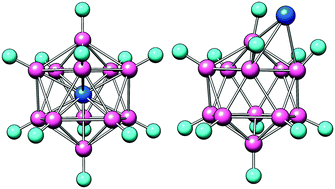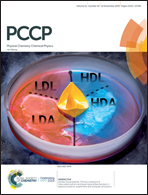Lanthanide and actinide doped B12H122− and Al12H122− clusters: new magnetic superatoms with f-block elements†
Abstract
In recent years, actinide containing clusters have attracted immense attention because of the distinctive bonding properties of their 5f and 6d electrons. In this context, in the present work, we have studied the isoelectronic series of actinide (An = Np+, Pu2+, Am3+) doped B12H122− and Al12H122− clusters using density functional theory (DFT). Similarly, corresponding isoelectronic lanthanide (Ln = Pm+, Sm2+, Eu3+) doped clusters are also investigated using DFT for comparison. Both exohedral and endohedral metal doped Al12H122− clusters are investigated in various possible spin states, whereas for B12H122− only exohedral metal doped clusters are studied due to its smaller cage diameter. Among all the metal doped clusters, the exohedral metal doped B12H122− and Al12H122− clusters in a septet spin state with retained high spin population on the doped actinide ion, are the most stable, indicating that all these doped clusters are magnetic in nature. The high stability of exohedral clusters is due to small steric repulsion as compared to that in the corresponding endohedral clusters. A prominent charge transfer from cage to metal ion is responsible for the strong interaction of the doped metal ion with the cage atoms. The studied Ln@B12H122− (Ln@Al12H122−) and An@B12H122− (An@Al12H122−) clusters are not only thermodynamically stable, but also kinetically stable. Metal ion encapsulated endohedral Al12H122− clusters are found to satisfy the 32-electron principle corresponding to the completely filled s, p, d and f shells of the central f-block atom. Theoretical predictions of these lanthanide and actinide doped stable B12H122− and Al12H122− clusters could encourage experimentalists for the preparation of these metal-doped clusters. Thus, the present work offers borane and alane clusters as new hosts for encapsulating radioactive actinides. Furthermore, various functional derivatives of these actinide doped B12H122− clusters may find applications in the field of radiation medicine.



 Please wait while we load your content...
Please wait while we load your content...